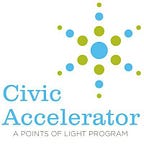Fresh off our trip to San Francisco for the annual Social Capital Markets convening (SOCAP15), we want to share our lessons learned from the dozens of incredible conversations, expert speakers, and events throughout the week. It was a long 4 days but between leading workshops, reuniting with CivicX alumni, making new connections and sparking new partnerships, we were able to digest these 3 trends overheard at SOCAP15.
1. Blended Capital — YES!
The “Pioneer Gap” has been a recurring them during past SOCAP conferences and almost every conversation I’ve ever observed on Impact Investing. The premise is that early stage social ventures (for-profit and nonprofit alike) are often working in emerging industries, developing regions, and otherwise “risky” markets. Thus, due to this increased risk there is less investment capital available than what is required by such ventures to scale their business models and social impact.
Leading organizations in the sector have made the case for unlocking philanthropic investment to fill the “pioneer” gap. Yet, barriers such as inability to make grants to for-profit entities, strict guidelines around evidence-based programs, and impact measurement requirements have created difficulties for venture philanthropists wanting to step up to the challenge.
Rather than continuing to ask the same question, “How can we unlock more seed capital for early stage social ventures?,” this year’s discussions at SOCAP15 offered concrete examples of how philanthropic and traditional investors are executing blended capital strategies together while maximizing returns for both types of funders.
For example, Echoing Green, a venture philanthropist, has a mission to invest in and support emerging social leaders. Their fellowship provides leadership development support (in kind and financial) for emerging social entrepreneurs who otherwise would likely sacrifice acquiring key talent to grow and scale their ventures. This type of philanthropic support can de-risk a traditional investment meant to support product development or market expansion since the investor is assured that the founding team will remain supported through the venture’s early growth. For a full review of this example and others shared at SOCAP15, check out this session recap by Patrick Mullen from the Sorensen Center.
Did you make it to SOCAP15? What were some of the trends you noticed or key take-a-ways? Let us know in the comments or share with us on Twitter.
2. Investment Readiness — AKA it’s okay to hire consultants
In order for most ventures to successfully commercialize their innovation, scale to multiple markets and consumers, and create meaningful social impact within a reasonable amount of time, a significant investment of capital and support is required. In the words of one SOCAP15 speaker, “we will not save the world one $25,000 grant at at time.” However, founding teams are often under-prepared and under-resourced to put large installments of capital and resources to work effectively. The question remains: “How can we ensure that a social venture is fully equipped and able to receive a substantial investment that will allow for maximum business scale and social impact?
During one particular session led by Anthony Bugg Levine from the Nonprofit Fund with participants from The Impact Programme, CAN, The Difference Incubator, and the SBI Group, there were a few examples that highlighted the business and the impact case for investing in venture capacity.
- The philanthropic community can achieve a significant social return on investment by investing in human capital and consulting services (impact measurement, operations, technical assistance, etc.). A report released at SOCAP15 by SBI detailed the outcomes of the UK Investment and Contract Readiness Fund, where £13.2 million invested across 155 nonprofit organizations to increase their capacity and investment readiness led to a total of £233 million in investments and contracts received by those organizations. You can read the full report and case study here.
- There is an opportunity to mobilize a significant number of skills-based volunteers to prepare social ventures for investment in the areas listed above — technology, operations, evaluation, finance, etc. All panelists noted that they have seen an increase in demand by professionals for these types of volunteers opportunities, and that a supportive network and infrastructure to connect volunteers with relevant and meaningful opportunities is forming. I can think of another organization that is leading efforts here as well…
3. Diversity
The opening plenary for SOCAP15 was truly inspiring, and drove home a core message that resonated throughout the rest of the conference:
Those creating products and services for the poorest of the poor, the bottom of pyramid, marginalized populations, and depressed communities MUST include representatives from those communities, demographics and regions in their decision-making and leadership. The Next System Project, led by Gar Alperovitz, has brought a rock star group of community organizers, policy makers, and business leaders together to promote and encourage participatory problem solving and innovation for the world’s toughest social issues. I highly recommend watching (or re-watching) this discussion. Start at 12:00, then sit back and be inspired through the moment when Michelle Long from BALLE leaves the audience desperate for more after the producer calls “time”.
